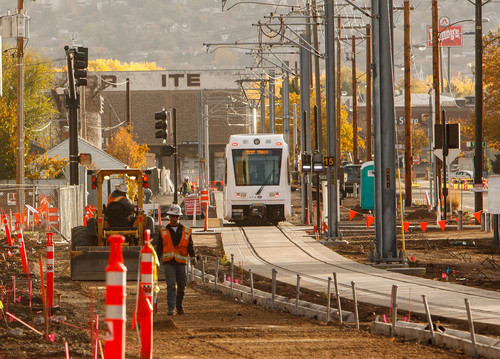This is an archived article that was published on sltrib.com in 2013, and information in the article may be outdated. It is provided only for personal research purposes and may not be reprinted.
The federal government expected 3,000 people a day to ride the new Sugar House Streetcar when it opened, according to a statement it issued in 2010 to announce a $26 million grant for the project.
But the average during its opening week was just 781 riders daily — a mere 26 percent of what had been projected, according to Utah Transit Authority data requested by The Salt Lake Tribune.
The UTA and Salt Lake City offer several explanations why projections and reality are so far apart initially. They also say the numbers should turn around as numerous residential and commercial projects now underway near the line are completed.
Salt Lake City Transportation Director Robin Hutcheson said the application for the federal grant used a projection model that "took into account the upcoming development" the line was expected to attract in both her city and South Salt Lake before it actually opened. That model projected 3,000 riders a day at opening, and 4,000 a day by 2030.
"With the economic downturn some projects were delayed," she said.
Hutcheson said 110 new residential units were finished in Sugar House, and another 700 are under construction now. "Additionally, approximately 110,000 square feet of retail will also be added." Salt Lake City Mayor Ralph Becker said at the grand opening of the line that the streetcar had attracted $400 million in development to Sugar House.
South Salt Lake Mayor Cherie Wood said it has attracted 1 million square feet of new retail development, 350,000 square feet of office space and 3,000 new residential units in her city.
"Since the line opened so quickly — before some of the hundreds of millions [of dollars] of planned development in Sugar House and South Salt Lake City could be completed — the 3,000 number is not really an accurate comparison for opening day," UTA spokesman Remi Barron said. "As the economy has begun to recover, much of the planned development is under way or will be soon."
Hutcheson said a key consideration to win the federal grant was the expectation that it would attract development, and noted it was called a Transportation Investment Generating Economic Recovery (TIGER) grant. "It was very much about ... development, economic development, and most importantly job creation," which she says the project accomplished.
Hutcheson and Barron said as part of an environmental assessment for the project, planners also made a different type of projection that did not take into account planned development. It projected 2,000 riders a day by 2030, and did not include a projection for opening day.
The 2010 federal grant announcement using the 3,000-rider projection also said the line would offer service every 15 minutes. It offers service every 20 minutes instead — in part because it has only a single track for most of its 2-mile distance, with only a small stretch of double track to allow cars to pass at about its midpoint.
Hutcheson said the project did not win the full amount sought in the grant application, which forced some cutbacks.
Despite the initially low numbers, Barron said, "UTA feels that the launch of this streetcar was a success and the people in Salt Lake City and South Salt Lake City have already embraced the S-Line."
He added, "As residential and commercial developments are completed, and as the weather improves and people are able to walk around the area more comfortably, we expect ridership to increase." Hutcheson concurred.
The low numbers come despite a limited-time offer of $1 fares for people who pay with electronic media. The regular cash fare is $2.50. On a special preview day, when a can of food for the poor was good for fare, the streetcar line had 2,312 boardings.
It's not the first time that recent rail projects did not live up to projections at opening, nor the first time that officials blamed the discrepancy on slow development.
The West Valley City section of the green line had only 69 percent of the projected 3,300 riders in its opening month. The red line extension to South Jordan, which opened the same day, had only half its projected 5,500 riders in the opening month. UTA officials at the time blamed that on development that was slower to occur than anticipated, and said ridership was on track to hit projections by 2015.
One line that exceeded expectations was the green line extension to Salt Lake City International Airport. It had 4,800 average riders a day in the first week it opened in April, a notch above the 4,600 a day that had been projected.







